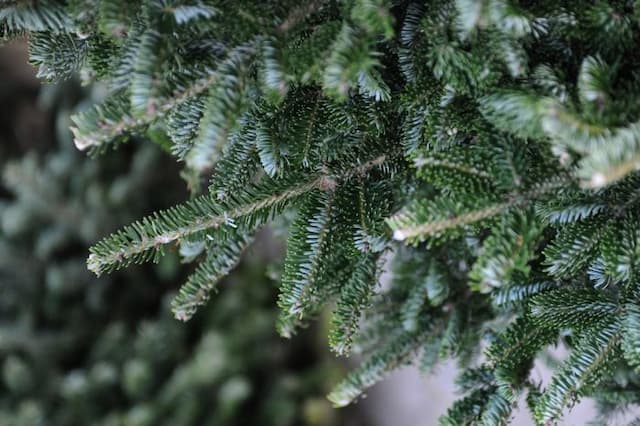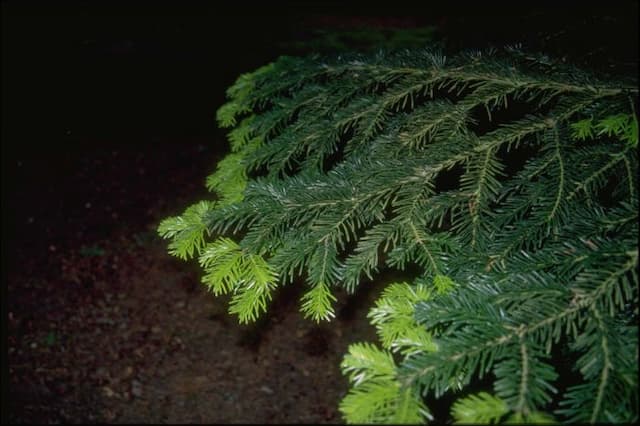Monterey Pine Pinus radiata Aurea Group

ABOUT
The Monterey pine, known specifically in the Aurea Group variant, boasts distinctive characteristics which contribute to its unique appearance. The most striking feature is the coloration of its foliage, presenting a golden-yellow hue that adds a splash of brightness, particularly to winter landscapes. This golden coloration is more prominent in the new growth and tends to be at its brightest when the needles first emerge and during the colder months. The plant's needles are arranged in bundles, typical of many pines, with each bundle consisting of three individual needles. These needles have a soft, somewhat flexible texture. They contrast against the darker, mature foliage that may take on a deeper green shade, giving the plant a multi-dimensional and textured appearance. The Monterey pine also produces cones, which carry the seeds. The cones are usually symmetrically shaped and have a woody texture. They are not significantly large but are noticeable among the green and gold needles. These seed cones will start out green and gradually turn to a brown tone as they mature and ripen. Overall, the Monterey pine, particularly in the Aurea Group, is appreciated for its colorful foliage which brings a vibrant golden touch to landscapes. The contrast between the new, bright yellow-green needles and the older, darker foliage creates a full, lush look. The presence of cones provides a further point of interest in this visually striking plant.
About this plant
 Names
NamesFamily
Pinaceae.
Synonyms
Monterey Pine, Radiata Pine, Insignis Pine, Monterey Pin.
Common names
Pinus radiata Aurea Group.
 Toxicity
ToxicityTo humans
Monterey Pine is generally not considered toxic to humans. There isn't any well-documented toxicity associated with Monterey Pine, and it's not known to cause poisoning if ingested. However, as with any plant, individual allergies or sensitivities could occur, which could lead to adverse reactions in some people.
To pets
Monterey Pine is not typically listed as a toxic plant for pets. It is not known to cause serious poisoning in animals if ingested. Nevertheless, ingestion of plant material can sometimes lead to gastrointestinal upset in pets such as vomiting or diarrhea due to the fibrous and resinous nature of the plant, rather than direct toxicity. If a pet is observed eating Monterey Pine and exhibits symptoms, it's wise to consult a veterinarian.
 Characteristics
CharacteristicsLife cycle
Perennials
Foliage type
Evergreen
Color of leaves
Green
Height
100 feet (30 meters)
Spread
25 feet (7.5 meters)
Plant type
Tree
Hardiness zones
7
Native area
California
Benefits
 General Benefits
General Benefits- Landscape Value: The Monterey Pine 'Aurea Group' adds aesthetic appeal to landscapes with its unique golden-colored needles and distinctive form.
- Shade Provision: Can offer a pleasant shaded area during sunny days, which can be beneficial for outdoor activities and comfort.
- Habitat for Wildlife: Provides habitat and nesting sites for various birds and other wildlife, contributing to local biodiversity.
- Erosion Control: The extensive root system helps stabilize the soil and prevent erosion, especially in sloped areas.
- Windbreak: Acts as a barrier against strong winds, thereby protecting soil, other plants, and buildings from wind damage.
- Sound Barrier: The density of the foliage can help reduce noise pollution, creating a more tranquil environment.
- Privacy Screening: Tall and dense growth habit makes it an effective natural screen for increased privacy on properties.
- Seasonal Interest: Offers seasonal visual interest with its evergreen foliage and, in some cases, cones that persist throughout the year.
 Medical Properties
Medical PropertiesThis plant is not used for medical purposes.
 Air-purifying Qualities
Air-purifying QualitiesThis plant is not specifically known for air purifying qualities.
 Other Uses
Other Uses- Woodworking Projects: The wood of the Monterey pine is workable and can be used for making small-scale woodworking projects, like crafts, model making, or as a material in hobbyist kit-building.
- Education: This species is often used in educational settings such as schools and arboretums to teach about conifer growth, forestry practices, and ecological significance.
- Erosion Control: Owing to its fast growth and extensive root system, it can be planted to help stabilize soil and prevent erosion on hillsides and slopes.
- Christmas Trees: The Monterey pine is cultivated for use as a Christmas tree due to its symmetrical shape and appealing look during the festive season.
- Bonsai Cultivation: Enthusiasts may use Monterey pine for creating bonsai trees, valuing its adaptability and the ease of training its branches.
- Windbreaks & Shelterbelts: Planted in rows, it serves as an effective windbreak or shelterbelt that protects crops and soil from wind erosion.
- Pine Needles for Mulch: The needles that drop can be gathered and used as a natural, acidic mulch for gardens, especially benefiting plants that prefer acidic soils.
- Sound Barrier: When planted densely, it acts as a natural sound barrier, which can help reduce noise pollution from roads or industrial areas.
- Habitat Restoration: It is sometimes used in projects aimed at restoring native habitats or creating new forests for wildlife.
- Holiday Crafts: Cones and branches of the Monterey pine are often used for making holiday wreaths, garlands, and other seasonal decorations.
Interesting Facts
 Feng Shui
Feng ShuiThe Monterey pine is not used in Feng Shui practice.
 Zodiac Sign Compitability
Zodiac Sign CompitabilityThe Monterey pine is not used in astrology practice.
 Plant Symbolism
Plant Symbolism- Resilience - The Pinus radiata, commonly known as the Monterey pine, is known for its resilient nature, able to grow in a variety of climates and conditions, representing the ability to endure and adapt.
- Longevity - Pines in general signify long life and immortality, reflecting the long lifespan of these trees which can live for many years.
- Wisdom - With age, pines are often associated with wisdom as they stand tall and strong, witnessing the passage of time and the cycles of life.
- Fertility - The prolific seed production of the Monterey pine symbolizes fertility and creative abundance.
- Peace - Pines often represent serenity and peace, providing calm and soothing energy, reflecting their evergreen nature and the tranquil environments they create.
 Water
WaterThe Monterey pine Aurea group requires watering that ensures the soil remains moist but not waterlogged. Generally, water deeply every two to four weeks, providing about 1-2 gallons of water for each watering session, depending on the size of the tree and the weather conditions. During the growing season in spring and summer, you may need to water more frequently, especially if conditions are particularly dry or hot. In fall and winter, reduce watering but do not allow the soil to become completely dry. Adjust the amount and frequency based on rainfall and the pine's response to the watering schedule.
 Light
LightThe Monterey pine Aurea group thrives in full sunlight with at least six hours of direct, unfiltered sunlight each day. The best spot for the plant is in an open area, away from large buildings or trees that could shade it. This variety adapts well to various light conditions but performs best with ample sunlight, ensuring strong growth and health.
 Temperature
TemperatureThe Monterey pine Aurea group is suited to a range of temperatures, capable of handling temperatures as low as 20°F and as high as 100°F. The ideal temperature conditions for this pine lie between 60°F and 75°F. Avoid placing the tree in areas that experience extreme temperature fluctuations to prevent stress and maintain optimal health.
 Pruning
PruningPrune the Monterey pine Aurea group to remove dead, diseased, or broken branches, and to shape the tree if desired. The best time for pruning is late winter or early spring before the start of the new growth cycle. Typically, this plant requires minimal pruning; however, you should inspect it annually and make cuts as necessary to maintain tree health and appearance.
 Cleaning
CleaningAs needed
 Soil
SoilMonterey Pine needs well-draining, slightly acidic to neutral soil, with ideal pH range of 5.5 to 7.0. A mixture of loam, sand, and organic compost is suitable to cater to its growth needs.
 Repotting
RepottingMonterey Pines do not require frequent repotting and can often remain in the same pot for several years as they prefer not to be disturbed too often.
 Humidity & Misting
Humidity & MistingMonterey Pine thrives in moderate to low humidity environments typical of outdoor conditions and does not necessitate high humidity levels.
 Suitable locations
Suitable locationsIndoor
Provide bright light, cool temps, air, and don't overheat.
Outdoor
Full sun, protect from strong winds, avoid wet soils.
Hardiness zone
7-10 USDA
 Life cycle
Life cycleThe life of Monterey Pine 'Aurea', as Pinus radiata Aurea Group is commonly known, begins with seed germination, which occurs in favorable conditions of moisture and temperature. The seedlings emerge and grow into juvenile saplings, a stage characterized by rapid height growth and the development of a strong root system. As the tree matures, it enters the reproductive stage, forming both male and female cones; the male cones release pollen, which is carried by wind to fertilize female cones. After pollination and fertilization, seeds develop within the female cones and, once mature, are released to start a new generation. The adult trees continue to grow in size and can live for several decades, after which they reach the senescence stage, experiencing reduced growth and vitality before eventually dying. Throughout its life cycle, the Monterey Pine 'Aurea' may undergo cycles of cone production and vegetative growth, depending on environmental conditions.
 Propogation
PropogationPropogation time
Spring to summer
The most popular method of propagation for the Pinus radiata Aurea Group, commonly known as Monterey Pine 'Aurea', is through seed collection and germination. Seeds are generally collected from the cones in late summer to autumn. Cones may be placed in a warm, dry location to encourage them to open and release the seeds. The seeds then typically require a period of cold stratification, which can be achieved by placing them in a sealed container with moist sand or peat moss and refrigerating for about 4 to 8 weeks. After stratification, seeds are sown in containers filled with a well-draining seed starting mix. They should be lightly covered with the mix and kept consistently moist until germination, which can take several weeks. Seedlings should grow in a protected environment until they are strong enough to withstand outdoor conditions.








